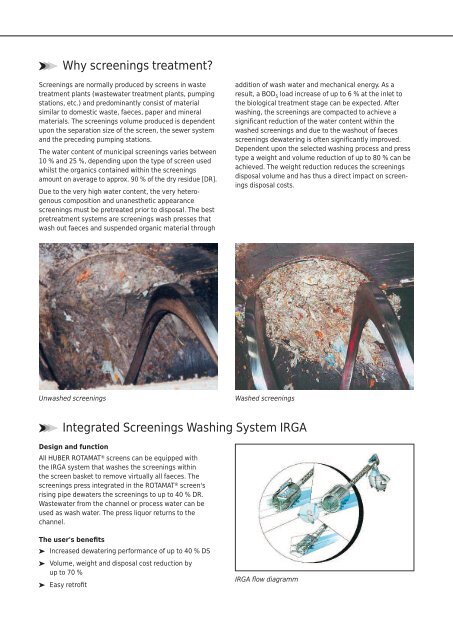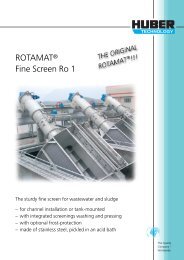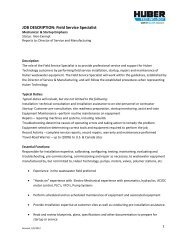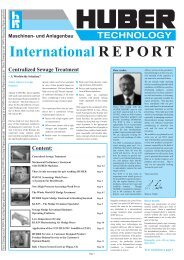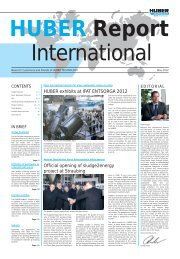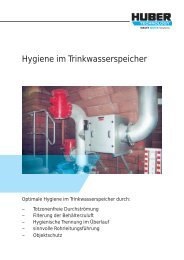Overview Brochure Screenings Treatment - huber se
Overview Brochure Screenings Treatment - huber se
Overview Brochure Screenings Treatment - huber se
You also want an ePaper? Increase the reach of your titles
YUMPU automatically turns print PDFs into web optimized ePapers that Google loves.
➤ Why screenings treatment?<br />
<strong>Screenings</strong> are normally produced by screens in waste<br />
treatment plants (wastewater treatment plants, pumping<br />
stations, etc.) and predominantly consist of material<br />
similar to domestic waste, faeces, paper and mineral<br />
materials. The screenings volume produced is dependent<br />
upon the <strong>se</strong>paration size of the screen, the <strong>se</strong>wer system<br />
and the pre ceding pumping stations.<br />
The water content of municipal screenings varies between<br />
10 % and 25 %, depending upon the type of screen u<strong>se</strong>d<br />
whilst the organics contained within the screenings<br />
amount on average to approx. 90 % of the dry residue [DR].<br />
Due to the very high water content, the very hetero -<br />
genous composition and unanesthetic appearance<br />
screenings must be pretreated prior to disposal. The best<br />
pretreatment systems are screenings wash pres<strong>se</strong>s that<br />
wash out faeces and suspended organic material through<br />
addition of wash water and mecha nical energy. As a<br />
result, a BOD 5 load increa<strong>se</strong> of up to 6 % at the inlet to<br />
the biological treatment stage can be expected. After<br />
washing, the screenings are compacted to achieve a<br />
significant reduction of the water content within the<br />
washed screenings and due to the washout of faeces<br />
screenings dewatering is often significantly improved.<br />
Dependent upon the <strong>se</strong>lected washing process and press<br />
type a weight and volume reduction of up to 80 % can be<br />
achieved. The weight reduction reduces the screenings<br />
disposal volume and has thus a direct impact on screen -<br />
ings disposal costs.<br />
Unwashed screenings<br />
Washed screenings<br />
➤ Integrated <strong>Screenings</strong> Washing System IRGA<br />
Design and function<br />
All HUBER ROTAMAT® screens can be equipped with<br />
the IRGA system that washes the screenings within<br />
the screen basket to remove virtually all faeces. The<br />
screenings press integrated in the ROTAMAT® screen's<br />
rising pipe dewaters the screenings to up to 40 % DR.<br />
Wastewater from the channel or process water can be<br />
u<strong>se</strong>d as wash water. The press liquor returns to the<br />
channel.<br />
The u<strong>se</strong>r's benefits<br />
➤ Increa<strong>se</strong>d dewatering performance of up to 40 % DS<br />
➤ Volume, weight and disposal cost reduction by<br />
up to 70 %<br />
➤ Easy retrofit<br />
IRGA flow diagramm


